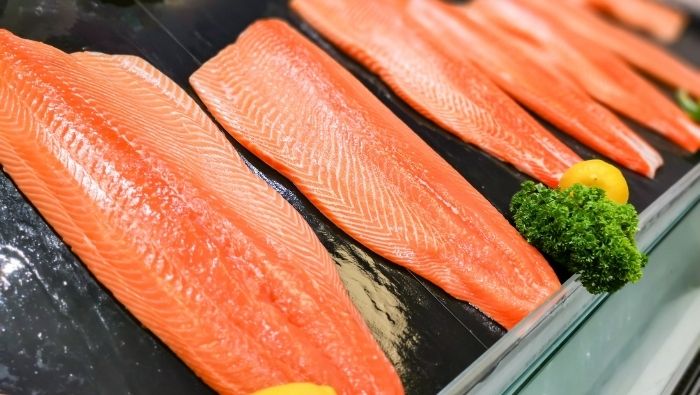Buying Better Seafood for Less

Many types of seafood do cost more than chicken, beef or pork, but that does not mean they can’t be part of a frugal food budget or that you have to limit yourself to frozen fried fish fillets. Use these tips to buy better seafood for less.
My family is from the south and I grew up eating seafood all the time. Seafood tastes better the closer you live to the coast. Sadly, I live in the city and have to suffer from the mediocre taste of seafood in my area.
I love seafood and can eat it all day, every day, but unfortunately, the prices of seafood up north are much higher than down south.
I have used dozens of methods to try to save money when buying seafood. It is difficult to find fresh seafood, especially fish. Most fish are farm-raised, which can cause health issues and do not provide the same health benefits as fresh fish. Some seafood is available year-round, while other seafood is only available at certain times. However, most seafood is available frozen throughout the year.
Here are some dynamite tips to use when buying seafood any time of the year.
Appearance
When purchasing fish, a thick glaze of ice should be on it that protects the fish. Fish should not be stored in a styrofoam container, covered with plastic wrap, stored in an ice chest or by any other unsafe methods.
Look for seafood with shiny skin, bright, clear eyes, no freezer burn, no milky liquid on the meat, tight skin, and brightly colored gills.
Fresh shrimp should look clear and smell like salt water. Frozen shrimp should look opaque.
Beware of fish fraud. Is this fish really wild salmon, red snapper, grouper, etc.?
Sign Up for Savings
Subscribe to get money-saving content by email that can help you stretch your dollars further.
Twice each week, you'll receive articles and tips that can help you free up and keep more of your hard-earned money, even on the tightest of budgets.
We respect your privacy. Unsubscribe at any time.
Venue
Avoid buying seafood that is imported. Overseas countries have different safety rules that are, in some cases, less strict or not enforced
Purchase seafood from a fish market, which has better quality seafood than grocery stores. Shop at a fish market with knowledgeable salespeople.
Labels
Beware of tricky labels such as “only caught in the wild,” “fresh farm-raised” (farm-raised fish are not fresh or wild), farmed Chilean seabass (it is not a seabass and is not from Chile), or “wild Atlantic salmon” (most Atlantic salmon is farm-raised because they are an endangered species).
There is no universal seafood labeling system for restaurants, grocery stores, or fish markets. However, the USDA requires all fish to carry a label identifying its country of origin and stating if it is wild-caught or farm-raised. Look for “Frozen-at-Sea” (FAS) fish that has been flash-frozen onboard the ship.
Look for certifications. If you cannot find a certification, buy seafood caught in North America.
Shellfish
Buy frozen shellfish unless you live near the coast or a local fishery.
Lobster prices drop in May and June. May is the best month to buy live lobsters. Hard shell lobster prices peak in August and drop again in September. After Labor Day, lobster prices drop and remain economical until Christmas. Prices increase as winter approaches.
Fresh shrimp is available between May and October.
Fresh Versus Frozen
Not every fish freezes well. Fish that can freeze well can still suffer quality if frozen too long.
You do not know how long the seafood sold at the grocery store has been thawed, so it is best to buy it frozen and defrost it yourself.
Maintaining Freshness
When purchasing fish, ask for it to be packed with a separate bag of crushed ice to keep it cold.
Refrigerate whole fish, fillets, or steaks for up to two days. Thaw frozen fish in the refrigerator.
Look for seafood that is vacuum-sealed to maintain freshness.
Cost
Sometimes farm-raised fish is sold as wild-caught fish and sold at a much higher price.
Out-of-season fish are harder to find in winter months. Buy fresh fish in-season to save money. Buy frozen fish out-of-season.
More Ways to Save Money
Whole fish offers more value for the per-pound price. Canned fish or smoked fish are budget-friendly options.
Shop when it is raining or during bad weather to get a good deal. Go later in the day or at night just before closing time. The selection may not be as good, but vendors are eager to sell everything rather than have leftover inventory.
Look for specials at fish markets or fisheries.
Buy seafood in two or three-month supplies.
You will pay more for seafood the farther you live away from the coast
Buy shrimp based on the count per pound. Shrimp sold at grocery store seafood counters have been shipped frozen and then thawed at the seafood counter. Shrimp sold in the frozen food section is the same as those sold “fresh” at the seafood counter.
Buy squid or octopus frozen if you do not live near a fish market or the coast.
Keep abreast of seafood alerts and information at Seafood Watch or The Safina Center.
Reviewed December 2023
Popular Articles
On After50Finances.com
- 9 Things You Need to Do Before You Retire
- You Didn’t Save Enough for Retirement and You’re 55+
- When Empty Nesters Reorganize and Declutter Their Home
- Reinventing Your Career in Your 50s or 60s
- What Mature Homeowners Should Know about Reverse Mortgages
- 2 Reasons to Collect Social Security Benefits As Soon As Possible


